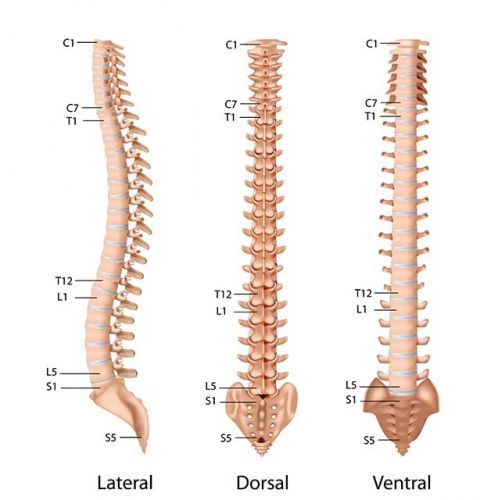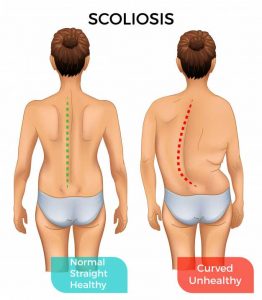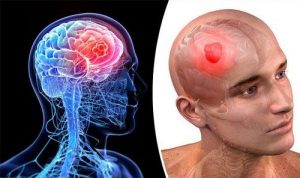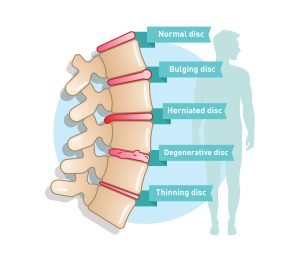What is the spine?
The spine is the central support structure of your body. It connects different parts of your musculoskeletal system. The spine helps you sit, stand, walk, twist, and bend. While back injuries, spinal cord conditions and other problems can damage the spine and cause back pain.
Structure and function of the spine
The key parts of the spine include the vertebrae (bones), discs, nerves, and spinal cord. The spine supports your body and helps you walk, turn, and move. The discs that press on the vertebrae may become compressed with age or injury, leading to a herniated disc. Exercises can strengthen the core muscles that support the spine and prevent back injuries and back pain.

Parts of the vertebral column
A healthy spine has three natural curves that create an S shape. These curves absorb shocks into your body and protect your spine from injury. The different parts of your spine make up:
Vertebrae: The spine has 33 vertebrae (small bones) that form the spinal canal. The spinal canal is a tunnel that houses the spinal cord and nerves and protects them from injury. Most vertebrae move to create range of motion. The lowest vertebrae (sacrum and coccyx) are fused together and do not move.
Facet joints: These joints of the spine have cartilage (sliding connective tissue) that allows the vertebrae to slide over each other. Fast joints allow you to rotate and give you flexibility and stability. These joints can cause arthritis and cause back pain or neck pain.
Intervertebral discs: These smooth, round cushions sit between the vertebrae and act as shock absorbers for the spine. Each disc has a soft, gel-like center (nucleus pulposus) surrounded by a flexible outer ring (annulus). Intervertebral discs are under constant pressure. A herniated disc may rupture and allow some of the nucleus accumbens to leak out. A herniated disc (also called a bulging, slipped, or ruptured disc) can be painful.
Spinal cord and nerves: The spinal cord is a column of nerves that travels through the spinal canal. The umbilical cord extends from the skull to the lower back. Thirty one pairs of nerves branch through the opening of the vertebrae (neural foramen). These nerves carry messages between the brain and muscles.
Soft tissues: Ligaments connect the vertebrae to hold the spine in position. Muscles support your back and help you move. Tendons connect muscles to bones and help with movement.
What parts does the vital skeletal part of the body include?
Vertebrae make up five distinct sections of the spine. These parts, starting from the neck and going down to the hips (back end), are:
Cervical (Neck): The upper part of the spine has seven vertebrae (C1 to C7). These cervical vertebrae allow you to turn, tilt, and shake your head. The cervical spine forms an inward C-shape, which is called a lordosis curve.
Thoracic (middle back): The thoracic or thoracic part of the spine has 12 vertebrae (T1 to T12). Your ribs attach to your thoracic spine. This part of the spine bends slightly outward to create a backward C shape called a kyphotic curve.
Lumbar (lumbar): Five vertebrae (L1 to L5) make up the lower part of the spine. Your lumbar spine supports the upper parts of your spine. It attaches to the pelvis and bears most of your body weight as well as the stress of lifting and carrying things. Many back problems occur in the lumbar spine. The lumbar spine bends inward to create a C-shaped lordotic curve.
Sacrum: This triangular bone connects to the hip. The five sacral vertebrae (S1 to S5) fuse together as the baby grows in the womb, meaning they don’t move. The sacrum and the pelvis form a ring called the pelvic girdle.
Coccyx: Four fused vertebrae make up this small piece of bone found at the bottom of the spine. The muscles and ligaments of the pelvic floor attach to the coccyx.

Cervical spine anatomy guide
The cervical spine, or the cervical part of the spine, consists of seven vertebrae, which are indicated by the letters C1 to C7. These beads are numbered from top to bottom. The structure and formation of these beads is as follows:
C1 (Atlantoaxial or Atlas): This vertebra is somehow different from the vertebra of the cervical spine and instead of a disc, it has a collar called “axis”.
C2 to C6: These vertebrae are known as the main cervical vertebrae and each has a disc between them.
C7 (cervical vertebra): This vertebra is the last vertebra in the cervical spine and is a kind of transition between the cervical spine and the absorbing spine.
Along the cervical spine, each vertebra has three main components:
Superior Articular Facet: The part of the vertebra that communicates with the upper vertebra.
Inferior Articular Facet: A part of the vertebra that is connected to the lower vertebra.
Ventral Body: The front part of the vertebra, which is tube-shaped and located along the cervical spine.
In addition, in each vertebra of the cervical spine, spinal cords pass from the brain to the body. These nerves play a role in performing motor and sensory tasks in the neck and other upper parts of the body.
The cervical spine is a very sensitive and important component of the body’s skeleton and is also involved in maintaining the endurance and flexibility of the neck and spine in general.



Scoliosis or lateral deviation of the lumbar spine
The curvature or deviation of the vertebral column is interpreted as scoliosis What is scoliosis? This complication is a lateral deviation of the vertebral

What is a brain tumor and what are its complications?
A brain tumor is an abnormal growth of brain cells or surrounding tissues. What is a brain tumor? Brain Tumor Growth and expansion

What diseases can the spine be exposed to?
Diseases and disorders of the spine The spine is an important part of the human skeletal structure and is composed of vertebrae, discs, muscles,

The latest research in the field of spinal canal stenosis, causes, symptoms and treatment methods
What is spinal stenosis? Spinal stenosis is a medical condition that results in blockage or narrowing of the spinal canal. This spinal canal is
